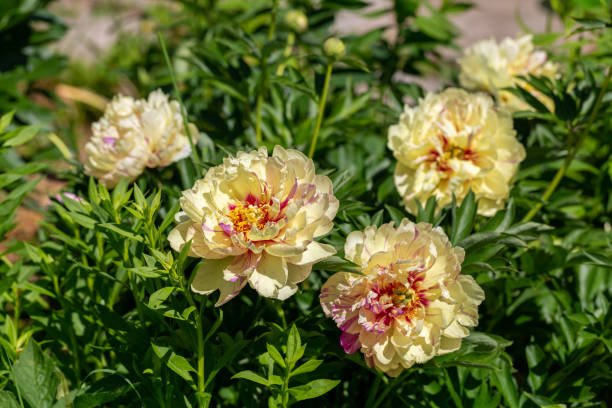Itoh Peony Care Instructions.
The intersectional peony, which is also known as the Itoh peony blossom, is a hybrid flower that was created by crossing herbaceous peonies with tree peonies. The Itoh peony is resistant to a wide range of climates, from USDA Zones 3a to 8a, thanks to the fact that it inherits the best characteristics of both of its parents.
These flowers feature sturdy branches, big blooms that stay for a long time, and foliage that is dark green, rich, and deeply lobed.
This foliage remains on the plant until fall. Itoh peonies come in a wide range of brilliant hues, including yellow, coral, pink, red, and white, and their blooms may grow to be as wide as 8 inches across.
These are generally slow-maturing plants, and it may take seedlings anywhere from three to four years before they begin to blossom, despite the fact that the foliage develops quite fast.
However, potted nursery plants are typically at least two years old before they are marketed, and a nice robust one-gallon nursery specimen may supply you with flowers in its first year. If you purchase bare roots over the mail, you can anticipate somewhat sluggish development for the first year or two.
Due to the presence of paeonol in the leaves, roots, and stems of peonies, they provide a moderate risk of poisoning to canines, felines, and horses.
Peony Care from Itoh
Itoh peonies are often planted in the same manner as herbaceous peonies are grown. When you buy plants from a nursery that are already potted, it is ideal to plant them as soon as possible rather than having them stay in their pots for an excessive amount of time. Keep in mind that these are enormous plants, so place them at a distance of three to four feet from any other plants or peonies.
The optimum time to plant itoh peony is in the spring, as soon as the soil can be worked. Correctly prepare the planting hole by using additives, if necessary, to increase the drainage capabilities of the soil.
When growing peony in areas with a cooler climate, the root ball should be buried about two inches deeper in the soil. When planting in warmer areas, the root ball should only be partially covered.
Do not cover the root region with mulch or an excessive amount of dirt, as this might suffocate the roots and diminish the amount of flowering that occurs.
After they have been established, these plants need very little attention but should be fed on a regular basis. Because Itoh peonies have inherited the sturdy stems of the tree peony, gardeners do not need to bother about anchoring them because it is unlikely that they would bend over in wind and rain.
In addition to this, they exhibit some resistance to several forms of peony blight, such as botrytis and phytopthora.
There are sometimes issues that might arise with herbaceous peonies.
Light
The foliage of the Itoh peony will develop thickly in full daylight, but in most cases, the peony’s blossoms will remain on the plant for a longer period of time if the plants are provided with some mild shade.
Water
If there hasn’t been any significant rainfall for more than two weeks, you should begin to water your Itoh peony in the spring when new growth begins. Be sure not to overwater the soil by doing so, but water it gently twice a week (no more than half an inch at a time).
Soaking the soil at ground level rather than watering plants from above, which might spread fungal spores from one plant to another, is the preferred method of watering plants.
Soil
Make sure that the soil in which you plant your Itoh peony is rich and has good drainage. These plants have a poor response when planted in soil that retains a lot of water and is quite thick. If your soil does not have pores, you need to be sure you amend it with a lot of organic matter.
Both the Temperature and the Humidity
Itoh peony are recognized for their ability to withstand temperatures as low as minus 25 degrees Fahrenheit during the winter. Itoh hybrids, on the other hand, do particularly well in warmer climes, such as the temperatures seen in zone 8.
They need a period of cold weather in the winter to reset themselves so that they can bloom the following spring, hence they do not fare well in climates where winter temperatures remain above freezing.
Itoh peony are tolerant of a wide variety of humidity levels; nevertheless, prolonged exposure to chilly, damp environments might favor the development of fungal infections.
Fertilizer
Peonies need three solid feedings a year: one in the early spring when the shoots begin to grow; another when the flower buds are just beginning to form; and a third in the autumn to stimulate root development before winter.
Utilize a fertilizer with a balance of 10-10-10 when fertilizing your Itoh peony in the spring and summer months; however, a fertilizer with a composition of 5-10-10 is recommended for use in the autumn. Itoh peony seem to benefit tremendously from receiving foliar feedings with water-soluble fertilizers.
Different kinds of Itoh Peony
There is a wide selection of kinds of Itoh peony for you to pick from, each having a bewildering assortment of bloom colors, sizes, and forms. When selecting a variety, it is important to pay attention to the hardiness zone ratings, since some are not able to withstand the freezing temperatures of zone.
Here are several popular varieties:
The ‘Garden Treasure’ cultivar is distinguished by its big, double, golden-yellow blooms. It may eventually reach a height of 30 inches and a width of 5 feet.
‘Border Charm’ is a yellow flowering plant that grows to a height of only 2 feet and has blooms that are medium-sized and semi-double.
‘New Millenium’ has coral pink semi-double blooms on plants that grow to a height of 28 inches.
The ‘Bartzella’ cultivar produces very enormous and vibrantly yellow double blooms, each of which has a little reddish center stain. The flowers also exude a somewhat spicy aroma. Plants may reach a height of 36 inches.
‘Keiko’ has huge blooms that may range from semi-double to double, and its dark lavender-pink petals fade to a light pink color.
Blooms of ‘Yankee Doodle Dandy’ are deep pink with cream overtones and may range from semi-double to double in size. It will eventually reach a height of 36 inches.
The ‘Takara’ cultivar has remarkable blooms that are yellow with a deep lavender-pink center and grow on 24- to 30-inch plants.
The blossoms of ‘Singing in the Rain’ begin as a buttery yellow color and progressively take on a salmon pink hue. It may reach a height of 1-2 meters.
Pruning
Peonies of the Itoh kind may have their spent flowers removed as required during the spring and summer months. By removing spent flowers from a plant, you may encourage it to produce more bouquets of flowers.
During the autumn, trim them so that they are approximately four to six inches above the soil level, or to the point when the stems die back. Itoh peonies, in the same way as herbaceous peonies do, will return from the ground in the spring.
Propagating Itoh Peonies
Root division has shown to be an efficient way of reproducing all Itoh peony for many generations. However, you should be aware that peony do not like to have their environment disrupted, and division should only be done when you wish to produce new plants.
It will be a few of years before the newly transplanted portions become established and healthy again. How to accomplish it is as follows:
Dig the whole root ball up with a shovel in the early spring, before the plant has begun its active development cycle.
After rinsing the roots so that you can see the root ball more clearly, cut through the top of the plant with a sharp knife to separate the plant into parts. Make sure that each piece has at least one sturdy root and that there are three to five eyes visible at the peak of the crown.
Plant the pieces in fresh places, being sure to bury the eyes slightly below the soil’s surface in each case. Instead of keeping the roots for an excessive amount of time before replanting, it is advisable to plant them as soon as possible.
How to Cultivate Itoh Peonies from Their Seeds
Itoh peony do not produce viable seeds when grown from seed. The only method of proliferation that is really viable is root division.
The Act of Planting and Replanting
Itoh peony can be cultivated in containers, even if this is not the conventional method. Because itoh peonies have such huge roots, you need to make sure that the container you select for them has a depth and width of at least 18 inches.
The container must to also have very good drainage. Even while container plants may withstand some frost, it is best to bring them inside for the winter, when they will need as much sunshine as you are able to give them.
Overwintering
In the weeks coming up to the onset of frost, give the plants plenty of water consistently. To prevent fungal spores from surviving the winter on the plant, remove and dispose of the plant’s leaves before winter arrives. When the stems get brown and brittle, cut them off so that they are just above the ground level.
However, be cautious not to cut off any of the crown growth buds while you do this. It is not necessary to use any other kind of winter protection; in fact, mulch may be detrimental to the plant’s health.
Insects and fungi that often affect plants
Itoh peony are far more resistant to the usual diseases that strike ordinary peonies, although you may still run into some of these issues with your plants:
There are many different kinds of insects, but chafer beetles and Japanese beetles are particularly fond of the plant’s buds and blossoms to eat. To get rid of the beetles on the plant, you may either pluck them off by hand or use a pesticide of your choice. Neem oil is an excellent choice since it is non-toxic.
Powdery mildew is a fungal disease that causes a powdery residue that is whitish-gray in color and covers the leaves.
It may not be appealing, but it seldom results in fatalities. Instead of watering the plants with an overhead spray, which may spread the spores from the ground onto the plants, it is best to water the plants at ground level and let them soak up the water.
Applying a coating of neem oil to the plant as soon as the first leaves appear may prevent the illness from taking root and spreading.
Botrytis is a fungal disease that may be fatal, but it is one that can be treated by frequently removing damaged plant sections or by applying substantial amounts of a suitable fungicide. It is particularly typical during extended stretches of weather that are chilly, damp, and humid.
How to Bring the Itoh Peony to Fruition
If you plant a fully established one-gallon specimen according to the instructions, you may anticipate 30 flowers during the first couple of years and up to 60 blossoms on a mature bush. When you buy a plant with bare roots, it may take the plant a number of years before it begins to blossom in a powerful manner.
There are various potential explanations for why an established plant may not blossom, including the following:
The peony was planted at a depth that is too great. The peony’s roots should be no more than 2 inches below the surface, and in warmer areas they should be even closer to the surface. Many gardeners have discovered that by just elevating the plant a few of inches above the surrounding dirt, they may coax the plant into producing more abundant blooms.
Insufficient sunlight: If neighboring trees and shrubs have grown to the point that they are beginning to cast shadow on your peony, some good, hard trimming of the plants that surround it may be able to restore your peony to its previous state of robust flowering.
Inadequate amounts of fertilizer: Peonies, similar to other hardy flowering plants, need frequent feeding in order to maintain blooming.
Incorrect deadheading: It is not always possible to identify the emerging buds from the spent flower heads while doing this task. During the process of deadheading, if you accidentally remove the immature buds by pinching them off, your peony will not produce any blooms.
Problems with the weather: despite the fact that Itoh peonies have a wider hardiness range than the majority of other peonies, an early frost in the range’s northern section might destroy the early flower buds and prevent them from blooming early in the season.
And in the warmer part of the range, if winter was unexpectedly mild, the peony won’t get the necessary time of frost that the plants need to reset themselves, so it won’t do as well there. These issues won’t last long, since the plant will revert to its typical flowering pattern the year after this one.
Problems That Are Typically Associated With Itoh Peony
Stems Wilt, Buds Die Back
Itoh peony, like other types of peonies, are susceptible to the botrytis fungus that produces these symptoms, even though the condition is rather uncommon. If botrytis is discovered in its early stages, it is possible to treat it; occasionally, all that is required is to remove and dispose of the infected plant parts. The disease may be eradicated using a wide range of fungicides.
Marks and Spots on the Leaves
These symptoms almost often point to the presence of a fungal infection of some kind. These diseases are very uncommon and may be treated by removing and killing the sections of the plant that are infected.
Keep the area around the ground clear of debris to avoid the fungus from hibernating and coming back the following year. A systemic fungicide is a treatment option for situations that are severe.
There are Ants All Over the Flowers.
Ants that cover peony buds and blossoms are not a concern in any way, shape, or form unless you plan to cut the blooms and bring them inside to show them.
Ants are attracted to the delicious nectar that peonies produce, but they do not consume the flowers and they do not do any damage to them. Ignore the ants, or shake or brush them off before picking the flowers for use inside, whatever you choose.
FAQ
How exactly should I include Itoh peonies into the landscape?
As is the case with the vast majority of peony species, these plants are a lovely addition to cut flower bouquets. They are regarded as being simple to cultivate, possess a remarkable beauty, and even exude a pleasant lemony aroma.
They are often located in perennial borders or in hedges that also include a variety of other shrubs. Itoh peonies may also be shown on their own as a standalone specimen.
What factors led to the development of this peony?
In the 1940s, a Japanese botanist by the name of Toichi Itoh was the first person to successfully cross a tree peony with a herbaceous peony. Finding a method that could effectively cross-pollinate tree peony and herbaceous peonies required a lot of time and effort since tree peonies and herbaceous peonies have distinct times of year when their flowers bloom.
After more than a decade had passed, the early triumphs finally blossomed into viable blooming specimens. Toichi Itoh had already died away by the time the first cultivars with names were granted patents in 1964.
How long does it take for an Itoh peony to bloom?
Itoh peony, like other types of peonies, is perennials that may survive for a very long time. There are still living descendants of the first breeding specimens, and plants that are more than half a century old are not uncommon.
How do I go about gathering the flowers?
Cut the stems before the blooms have opened, when the marble-sized buds are still firm to the touch but before the flowers have fully bloomed.
Put the stems in water, and give the blossoms time to start opening up. It is important to remember that the overall foliage of a plant should never be cut down by more than one-third while harvesting.
Camellia Care And Growing Instructions
Care Instructions For Japanese Pieris




